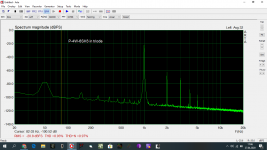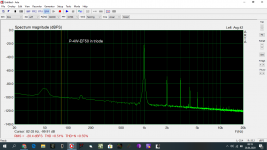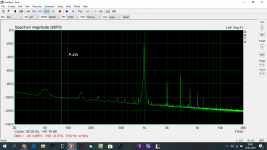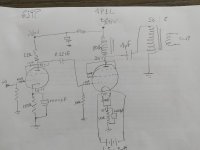Hello.
Only in the middle of the week I will carry out "blind tests" of the amplifier because apart from tube 3A5 I still have EF50 in triode and 6SH3 in triode. I will write the results.
Piotr
Only in the middle of the week I will carry out "blind tests" of the amplifier because apart from tube 3A5 I still have EF50 in triode and 6SH3 in triode. I will write the results.
Piotr
Attachments
Last edited:
Hello.
PSE4P1L+3A5parallel
Piotr
3A5 in parallel with 4P1L sounds great. I have this combo with IT to drive GM-70.
Hello,
PSE4P1L+2SH27L (2Ж27Л) in triode.
Piotr
PSE4P1L+2SH27L (2Ж27Л) in triode.
Piotr
Attachments
Last edited:
Do you have 2P29L? Ale Moglia described on his blog, that 2j27l sounded too thin for him. But feel free to try yourself of course 🙂Hello,
PSE4P1L+2SH27L (2Ж27Л) in triode.
Piotr
I made several other experiments and it stays. E88CC SRPP directly coupled to 4P1L pair still remains my BEST amp that Ive built. Ive posted the schematic several posts before.
Im now curious about all DHT amp. Power stage will be surely 4P1Lx2. But what about the driver? I have one pair of KC1 telefunken and E422 triotron (which is equivalent to RE134 TFK). Had anyone tried these?
Best regards, Michal
I've used 2P29L and it's OK and can take some current. I've used 26 but 7mA is a bit low current. I'm curious about using 3a5 at 10mA with both sections together - mu of 15 and DHT. 4P1L into 4P1L has never worked for me, but 4P1L into something like 300B or 6C4C is fine. I used to use PSE 4P1L but I've gone back to 300b. I'm assuming you have good access to Russian tubes.
Yes, this was also the point of my comment, that 2J27L cant do these currents.I've used 2P29L and it's OK and can take some current. I've used 26 but 7mA is a bit low current. I'm curious about using 3a5 at 10mA with both sections together - mu of 15 and DHT. 4P1L into 4P1L has never worked for me, but 4P1L into something like 300B or 6C4C is fine. I used to use PSE 4P1L but I've gone back to 300b. I'm assuming you have good access to Russian tubes.
Anyway, I dont have a 300Bs 😀 I have only one pair of 45s, and these I will probably sell (one tube will gone and I will not have a functional amp).
The E88Cc dc coupled worked really well with two 4P1Ls and current was something about 6 ma, same like with 26. Andy, have you tried these old european DHTs in some preamp design?
Best regards, Michal
You mean all those german tubes - RE etc? I had some but never really used them and sold them all. Do you have 6C4C? Cheap and a good 2a3 substitute. Drive them with a 4P1L. I'm about to try a 4P1L with a Hammond 157G as plate choke and a Russian 0.1uF FT-2 teflon cap x 2 for 0.2uF. These are the only coupling caps I use. I think 4P1L in filament bias (with choke in filament supply and Coleman Regs) makes a good driver, but since it doesn't sound good into PSE4P1L I'd use different output tubes. All DHT for me - nothing else! Except I use op-amps on the input for extra gain, usually NE5534
Yes, I mean those, for example RE134, KC1 etc...You mean all those german tubes - RE etc? I had some but never really used them and sold them all. Do you have 6C4C? Cheap and a good 2a3 substitute. Drive them with a 4P1L. I'm about to try a 4P1L with a Hammond 157G as plate choke and a Russian 0.1uF FT-2 teflon cap x 2 for 0.2uF. These are the only coupling caps I use. I think 4P1L in filament bias (with choke in filament supply and Coleman Regs) makes a good driver, but since it doesn't sound good into PSE4P1L I'd use different output tubes. All DHT for me - nothing else! Except I use op-amps on the input for extra gain, usually NE5534
I dont have 6C4C but this can be a way forward.... hmm...
Im purely a tube guy, who thinks about solid state (if) only in the output stage, but no at the input... Everything from AD1865 chip is tube.. How does it actually sound with the op amp?
Thanks. Michal
I think the op-amp input sounds good. I never would have thought of using an opamp but there's a NE5532 in the output of my DAC so I wondered about adding another op-amp stage. Sounds quite transparent to me - no coupling cap. I like the NE5534s. I use x5 gain.
You could just rejig the resistors around the DAC opamp output to change the gain of the opamp in the DAC and do away with the extra stage and its power supply if the DAC can be modded conveniently.
kind regards
Marek
kind regards
Marek
Hello Marek. Yes - altering the gain of the opamp in the DAC would be good if it could be done easily. Trouble is that it's all surface mount. I could look at other DACs that have leaded components, but they are getting rarer. I've never worked with SMDs. Big hands and eyesight not what it was!
What about to hack the signal right from the DAC leg (only 3 wires, I think this you can do even if its SMD) and then add simple Lampizator tube for extra gain, or something like JFET gain stage if you want?Hello Marek. Yes - altering the gain of the opamp in the DAC would be good if it could be done easily. Trouble is that it's all surface mount. I could look at other DACs that have leaded components, but they are getting rarer. I've never worked with SMDs. Big hands and eyesight not what it was!
Best regards, Michal
You mean hack the signal off the op-amp socket itself and replace the existing NE5532 stage with another op-amp stage with more gain? Does that sound straightforward or isn't it? I'm not too familiar with solid state.
Im also not familiar with solid state, but I meant this exactly. You will end up with only one op amp stage, or, some JFEt, etc....You mean hack the signal off the op-amp socket itself and replace the existing NE5532 stage with another op-amp stage with more gain? Does that sound straightforward or isn't it? I'm not too familiar with solid state.
Ive NEVER tried this (I only have a ad1865 DAC, then conversion resistor, and then a lampizator tube with no coupling). But Ive played in the past to original op amp output and it was 95% sound quality of the tubes 😀
By the way Andy - what DAC do you have? Is it delta sigma or R2R?
Best regards, Michal
Last edited:
I have a AK4490 DAC. I also have a Soekris and USB board I haven't configured yet - the connections need some figuring out.
All this isn't exactly off topic, since the output of the DAC we use is in the amplification chain. What I've done is take the opamp stage and increase the gain so it forms part of the amplifier. In theory..... Depends where you put it!
All this isn't exactly off topic, since the output of the DAC we use is in the amplification chain. What I've done is take the opamp stage and increase the gain so it forms part of the amplifier. In theory..... Depends where you put it!
Last edited:
Hmm, AK4490 is a delta sigma type DAC. Ive had in the past this chip (i hope I remember the right type number), and also a AK4396. These DACs sound good, but I found that delta sigma have a something "weird" in their sound - it is kind a unnatural and synthetic sounding. Only my opinion of course..I have a AK4490 DAC. I also have a Soekris and USB board I haven't configured yet - the connections need some figuring out.
All this isn't exactly off topic, since the output of the DAC we use is in the amplification chain. What I've done is take the opamp stage and increase the gain so it forms part of the amplifier. In theory..... Depends where you put it!
I advise you to try the Soekris (I think it has a R2R chip?).
Do you need help with connecting it?
Going back to the 4P1L, I built a driver stage using the Hammond 157G as a plate choke with FT-2 output cap. It sounds pretty nice to me. The 157G is used in the Hagerman Tuba headphone amp using an EL84, for instance. It's 30H and 40mA.
This raises the possibility of using one or two 157G in parafeed for a SE or PSE output stage. I can't remember if we've discussed parafeed on this thread. There are other plate choke choices, for instance these:
CHOKE20H80mA, 20H 80mA Choke | Hifi Collective £15.90++ 20H, 80mA
CHOKE25H50mA, 25H 50mA Choke | Hifi Collective £14.21++ 25H, 50mA
CHOKE40H30mA, 40H 30mA Choke | Hifi Collective £17.52++ 40H, 30mA
This raises the possibility of using one or two 157G in parafeed for a SE or PSE output stage. I can't remember if we've discussed parafeed on this thread. There are other plate choke choices, for instance these:
CHOKE20H80mA, 20H 80mA Choke | Hifi Collective £15.90++ 20H, 80mA
CHOKE25H50mA, 25H 50mA Choke | Hifi Collective £14.21++ 25H, 50mA
CHOKE40H30mA, 40H 30mA Choke | Hifi Collective £17.52++ 40H, 30mA
Hello guys, does someone have some guide or advice how to use it in a ultralinear connection?
I tried 2 4P1L paralell in ultralinear to a 3K5 output transformer with cca 43% tap (which was made originally to EL34). But it sounded very bad - harsh and sharp.
Thank you very much for any help. Best regards, Michal
I tried 2 4P1L paralell in ultralinear to a 3K5 output transformer with cca 43% tap (which was made originally to EL34). But it sounded very bad - harsh and sharp.
Thank you very much for any help. Best regards, Michal
Hello guys, does someone have some guide or advice how to use it in a ultralinear connection?
I tried 2 4P1L paralell in ultralinear to a 3K5 output transformer with cca 43% tap (which was made originally to EL34). But it sounded very bad - harsh and sharp.
Thank you very much for any help. Best regards, Michal
Why would you want an ultra-linear connection, if you can use it in pentode mode with feedback to the 1'St grid that yields much more linear result? The "Ultra-Linear" was used with tubes that have rare screen grid to simplify power supply. More linear pentodes with dense screen grids can't be used efficiently in ultra-linear connection. B+ would not be enough to get what they can offer otherwise.
The thread is about excellent results in triode mode. May be another thread for a pentode mode will reveal something interesting...
Well, after having read so many good words about this little tube, I decided to give it a try. I had bought a dozen of them some years ago and they were patiently waiting to be fired up. To be honest, my expectations were not that great, but, lately, I’m in the process of trying different output tubes, in an attempt to use a couple of parafeed output transformers that I had wound a couple of years ago, since the initial project was abandoned. Namely, it is an anode choke with an inductance of ca. 80 Hy at 60 mA and a parafeed output transformer with a primary reactance of 5K and a power rating of 5 Watts.
So, one afternoon, a couple of weeks ago, I sat on my bench and quickly assembled one channel on a wooden board with whatever I found easily on my hands. As a driver, I used a triode connected 6J9P run at a current of 10-11 mA. Filament supply for the 4P1L was taken from a Li-ion battery, charged at 4.0 Volts and biasing it with a capacitor bypassed cathode resistor. HV supply was from my lab power supply. Working parameters were the usual referred here, i.e., 240 V and 40 mA (see attached file for a rough schematic). All components were random items I had, nothing fancy, no «boutique» items. After checking everything on the bench, it was time to connect it to my system. The output power was measured ca. 1 W at the point where the tube was entering in class A2 mode.
Here, I must mention that I have a pair of quite sensitive loudspeakers, namely Tube Audio’s Marvel 2-way horns, with a sensitivity of 97 dBs, so I have the luxury to play with minuscule power amplifiers, one of the great advantages of having a sensitive speaker, which always pays of.
I connected the amplifier to my system and fired it up. From the first notes already, I realized that something great was happening here. Although listening to only one channel, I can always understand the character of the piece of equipment I’m listening to. Also, I must note that, whenever I conduct a listening test, I always make comparisons to a well known amplifier (which I use a reference point). For some years now, my reference amplifier is a 300B SE. Well, I must say that, although far from ideally constructed, the little 4P1L sounded clearly better than my 300B. In particular, bass, although not deeper, was more accurately controlled, mids and highs a bit cleaner. Particularly, I was impressed by the way it rendered voices, which I consider a key factor when judging an amplifier. All these findings were confirmed by a friend of mine, whom I invited to give me his view, since I greatly trust his acoustic opinion.
Having already been happy from what I was hearing, I started trying different drivers, in a conquest for a possibly better outcome. At first, I thought of making an all direct heated amplifier, so I tried an RE084, firstly with an anode choke load. Although my choke has an inductance of 200 Hy, I noticed a quick fall above 12 kHz, since Ra of this little tube is quite high at 8 kΩ. So, I changed this to a CCS (Garry Pimm’s self bias CCS), set at 4 mA. Now, the frequency response was better (it began dropping after 24 kHz), but I felt it was a little «anemic», since, with its low current, could not drive the 4P1L adequately. Nevertheless, I really liked its sound, especially nuances were there (BTW, I consider building a preamplifier with this tube).
Next, I thought of using a 4P1L to drive a 4P1L, as many of the members here have done. I loaded it with a choke, with a current of 20 mA and an anode-cathode voltage of 135 volts. To be honest, I didn’t like it so much, it was clearly inferior than the triode-strapped 6J9P. As I have read earlier in this thread, Andy Evans also had this opinion about this configuration. Also, since the gain was rather low for my set-up, I didn’t bother further trying different configurations (e.g., a CCS load).
So far, those are my experiences with the 4P1L. I have a couple of other things to try for a driver, like a triode-strapped 6E5P, a 5842 and, maybe, a 6C45P. I will definitely apply a filament bias scheme, using Rod Coleman's regulators.
The journey has just begun and I’m sure it will be long. But I’m also sure that I love this amplifier so much and that it will be my favorite piece, when I will eventually finish it.
So, one afternoon, a couple of weeks ago, I sat on my bench and quickly assembled one channel on a wooden board with whatever I found easily on my hands. As a driver, I used a triode connected 6J9P run at a current of 10-11 mA. Filament supply for the 4P1L was taken from a Li-ion battery, charged at 4.0 Volts and biasing it with a capacitor bypassed cathode resistor. HV supply was from my lab power supply. Working parameters were the usual referred here, i.e., 240 V and 40 mA (see attached file for a rough schematic). All components were random items I had, nothing fancy, no «boutique» items. After checking everything on the bench, it was time to connect it to my system. The output power was measured ca. 1 W at the point where the tube was entering in class A2 mode.
Here, I must mention that I have a pair of quite sensitive loudspeakers, namely Tube Audio’s Marvel 2-way horns, with a sensitivity of 97 dBs, so I have the luxury to play with minuscule power amplifiers, one of the great advantages of having a sensitive speaker, which always pays of.
I connected the amplifier to my system and fired it up. From the first notes already, I realized that something great was happening here. Although listening to only one channel, I can always understand the character of the piece of equipment I’m listening to. Also, I must note that, whenever I conduct a listening test, I always make comparisons to a well known amplifier (which I use a reference point). For some years now, my reference amplifier is a 300B SE. Well, I must say that, although far from ideally constructed, the little 4P1L sounded clearly better than my 300B. In particular, bass, although not deeper, was more accurately controlled, mids and highs a bit cleaner. Particularly, I was impressed by the way it rendered voices, which I consider a key factor when judging an amplifier. All these findings were confirmed by a friend of mine, whom I invited to give me his view, since I greatly trust his acoustic opinion.
Having already been happy from what I was hearing, I started trying different drivers, in a conquest for a possibly better outcome. At first, I thought of making an all direct heated amplifier, so I tried an RE084, firstly with an anode choke load. Although my choke has an inductance of 200 Hy, I noticed a quick fall above 12 kHz, since Ra of this little tube is quite high at 8 kΩ. So, I changed this to a CCS (Garry Pimm’s self bias CCS), set at 4 mA. Now, the frequency response was better (it began dropping after 24 kHz), but I felt it was a little «anemic», since, with its low current, could not drive the 4P1L adequately. Nevertheless, I really liked its sound, especially nuances were there (BTW, I consider building a preamplifier with this tube).
Next, I thought of using a 4P1L to drive a 4P1L, as many of the members here have done. I loaded it with a choke, with a current of 20 mA and an anode-cathode voltage of 135 volts. To be honest, I didn’t like it so much, it was clearly inferior than the triode-strapped 6J9P. As I have read earlier in this thread, Andy Evans also had this opinion about this configuration. Also, since the gain was rather low for my set-up, I didn’t bother further trying different configurations (e.g., a CCS load).
So far, those are my experiences with the 4P1L. I have a couple of other things to try for a driver, like a triode-strapped 6E5P, a 5842 and, maybe, a 6C45P. I will definitely apply a filament bias scheme, using Rod Coleman's regulators.
The journey has just begun and I’m sure it will be long. But I’m also sure that I love this amplifier so much and that it will be my favorite piece, when I will eventually finish it.
Attachments
- Home
- Amplifiers
- Tubes / Valves
- One more 4P1L SE




